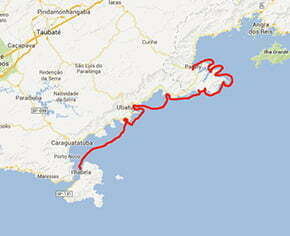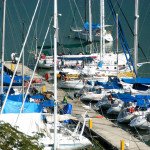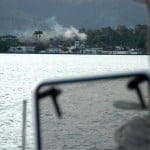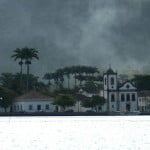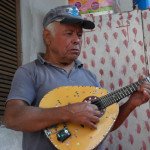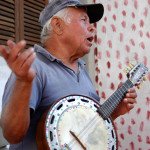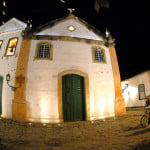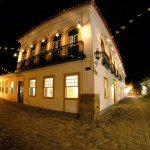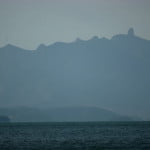Tuesday, 29 – 08 – 2006.
We started early this morning. A few minutes to 7 a.m. our guest, Maria Lucia Abaurre, had already arrived at home. And then Paulina arrived. We had to go to Santos to fetch Cardozo, our film maker who lives there, before taking BR 101, the road which here is called “Rio-Santos”, to Parati. We had planned on this first day of our trip to go alongside the beaches to shoot scenes of the damage caused by the road itself when it was built; consequently, the occupation in the neighboring areas, which are visible only if you pay attention. In regard to SP’s coast, the best thing to do if you want to show the real situation – the main goal of the Endless Sea Project – is to do it by boat and by car. From the sea you can see the beauty of the geography. A landscape designed by the contour of the Serra do Mar, and a coast full of small creeks, bays, islands, wonderful beaches – most of them damaged by the occupation – and covered with the remains of the Atlantic Forest. During the trip, you are astonished both when you see the beauty of the landscape and the damage caused by the occupation.
Going inwards by car you can see slums at the bottom of the Serra do Mar; they are behind most of the mansions on SP’s “north coast” beaches, an expression which is often used in talks or by the press to refer to the coast from São Sebastião to Bertioga. As if the coast from São Sebastião to Ubatuba’s north end, at Camburi beach, at Trindade End’s border, in the state of Rio de Janeiro, was not part of the north coast.
This type of trip takes a lot of time. You stop at every beach to take pictures and shoot. Sometimes, we interview emblematic local inhabitants; that’s why, if we want to have a profitable day, we must leave very early.
We went down the Serra do Mar and instead of going to Santos, I made a mistake and went to Peruibe, towards the south. I only noticed I was wrong one hour later, 60 kilometers in the wrong direction. We wasted the whole morning. When I arrived at the ferry to fetch Cardozo, it was almost midday. The weather didn’t help either. It was cloudy due to a cold front which had arrived a couple of days before.
Our first change of plans. We will try to shoot this part of the coast on our way back; maybe the weather will be better.
We went straight ahead until we crossed Ubatuba’s urban center where we saw condominium plaques which made us stop to investigate. One of the problems of Brazil’s coast occupation is the fact that it is irregular; it is either in forbidden areas, extremely dense, or some beaches are “privatized”.
The “entrance” used to go to Lázaro beach with a gate and a cabin for “guards” calls our attention. We are going there to know if we will be stopped or allowed to go in. I always say that beaches are public areas which belong to the Union, to all Brazilians. Nobody has the right to block the entrance to anyone. However, this violence is increasingly used on the Brazilian coast; especially, but not only, in the wealthier and more crowded states such as São Paulo and Rio. We saw the same situation in Alagoas, Ceara, Rio Grande do Norte, Pernambuco and Bahia. What changes is the level of intensity. In the Northeast it is less intense, whereas in the Southeast it is more.
We shot and took pictures. And then we got into the car and went to the “visitors’ entrance”. The guard wrote down my name and allowed us to go in. We crossed the condominium full of streets and houses, one right next to the other, as close as those in São Paulo. And then we arrived at the beach. It is really wonderful, it has a U shape and there is a sharp downward slope to the sea.
There are houses everywhere, beautiful and not very big with mini designed gardens; and guards, lots of them, monitoring our presence. I would describe their presence around us as embarrassing.
I don’t know if a humble person would be able to enter in this condominium; if this person succeeds, he or she will feel so bad that they will leave soon.
This is illegal, everybody knows that, but they don’t care. What a pity! It shouldn’t be necessarily like this.
Afterwards, we went to Parati’s marina.
When we unloaded our stuff, I saw Alonso who had stayed on board and waited for us. He looked pale and when he met me, he made the traditional sign with his thumb downwards. What happened? I asked. He repeated the sign. He didn’t say a single word. It was unnecessary. It was clear on his face: he was not feeling well. I took him immediately to Parati’s District Hospital where he was diagnosed as having a very high level of sugar. Alonso has diabetes and he also has high blood pressure. Our second change of plans.
We will give him medicine and hope he feels better and then start the trip.
I went back to the boat and went to Parati with the crew to have dinner. Everybody was starving.
And then we returned to the sailboat, enjoyed some fresh air in the cockpit and went to bed. It is unbelievable but it is extremely cold even here. I never saw this type of weather in Parati; usually, it is very hot due to the fact of being in the back of the bay and surrounded by high hills where there is rarely wind. Alonso told us that he had heard on the TV news that it had been the coldest afternoon of the year. The temperature in São Paulo was 9º. The thermal sensation produced by the wind was 3º and this was during the day.
That’s why even here it was cold. We slept in sleeping bags in the cabins.
Wednesday, 30 – 08 – 2006.
I thought that only Alonso and I could tell stories about the Endless Sea. Tonight I realized I was wrong. It was already dark when we had lunch with good wine to stand the cold weather. I said to the crew that I had written on the last logbook how lucky we had been during this journey with the Endless Sea. I recalled the situations I mentioned: grounding in the Calçoene River, entering in the Jequitinhonha River, and the control valve which had broken during the day when we were anchored here in Parati.
I heard signs of approval as well as other serious situations recalled by Paulina and Cardozo which could have cause
d serious damages, but nothing happened. I didn’t remember them any more. The first and more serious occurred when we crossed Mocooca’s canal, between Algodoal Island and the continent, in “Para’s holes” area. At the height of the village, there was a high tension wire crossing the entire canal. I looked at the sky from the prow to figure out the height of the wire versus our mast’s and I had to guide Fernando Cerdeira who was at the rudder:”move a little bit”, “one more time”. And then the sailcloth twisted around the top of the mast and touched the high tension wire. Afterwards, sparks and frightening noises echoed. Mini-lightning shone. Meanwhile, people at the shore looked at it amazed. We escaped by the skin of our teeth. If the wire had touched the aluminum of the mast and not the sail, I would have lost all the electronic equipment and maybe a member of the crew who might have been touching any metal at that moment. All of us would have grilled like barbecue. But it hit the cloth…
In Breves Hole, in the Amazon, one night our boat was trapped by a convoy of logs pushed by a barge. Huge logs tightened one to the other around the Endless Sea after a turn. An unusual accident which could have caused damages.
During the same trip, there was also a swarm of bees which made a beehive at the height of the crosshead of the big mast.
Cardozo reminded us of a tough moment when we entered in the Camocim’s Bar, in Ceara, with strong wind, a broken motor, on a low bottom and coral reefs in the entrance. It was really tough, although it wasn’t unexpected, since smaller rivers are simply drawn on nautical maps and their depth is not measured. To enter in a place like this you have to have a keen “eye” to see the different colors of the sea which show where it is deeper or not. So you “choose” the direction as you go on. In this type of situation and whenever there is no pilot available, we have a secret weapon: his name is Alonso. In spite of that it is very tough. In Camocim, part of the rocks are uncovered and the rest is submerged. I was in the rubber boat as a guide with a portable echo sounder; the sailboat was behind in Alonso’s hands. There is a continuous wall of reefs on both banks up to the middle of the bay, and then a free narrow entrance. We have to sail through that corridor with a crew who is not really well prepared, from 25 to 30 knots of wind. Right after this type of “gate”, with waves breaking on both sides, the depth suddenly drops from six to two meters, sometimes less. I started to push the sailboat to free it as soon as possible from that dangerous situation. I pushed the Endless Sea’s stern with the rubber boat prow. A higher wave makes the stern go up. The rubber boat goes down and clears up the way… If we ground here, I thought, it will be the end of the Endless Sea. But we succeeded.
They told three or four other stories which sounded new to me. The crew accumulates mileage and gains experience. I was surprised when I realized all the things we had learned; over four thousand miles sailed. This taught us a lot; not only in regard to environment and sea issues, but also in regard to the art of sailing, services on board, four different people living in an exiguous room, sometimes hostile. We were there for hours recalling the difficult situations we had gone through; and then I realized that each member of the crew already has a special, intimate and particular relationship with the boat and our trip. Memories that we will keep for the rest of our lives, because they are strong, unusual, and deal with our emotions. I woke up happy this morning.
Since we had to stay in Parati, we decided to go by car to the headquarters of the Serra do Mar State Park/ Picinguaba Center. We had already planned to do so by the time we would arrive in the area. So we took advantage of our presence in the area and went there to shoot. During this time of the year, you never know when a cold front is coming. We were welcomed by Fernanda Waet, the Public Usage Program’s Coordinator of Picinguaba Center/ Serra do Mar State Park.
The Center has 47 thousand hectares and at the north border there is the Bocaina Mountain National Park, in the state of Rio de Janeiro. The Serra do Mar Park goes southwards where the city of Pedro de Toledo is, near Peruibe. It is an area of 300 thousand hectares. It is under the administration of the Forest Institute connected with The Environmental Department of the State of São Paulo. They are in charge of the protection of the beaches, reefs, mangroves, rivers and water falls strategically placed by nature in the middle of the Atlantic Forest. This is the only point where the State Park reaches the shore.
We walked through a path that took us to a flour house of the 19th century, near the river of the Farm. We interviewed forester Joanice Cristo, hired by the Park. And then we went to a well of transparent water and then we went down up to the mouth on the beach of the Farm. A wonderful area which is not very occupied, at least in this small and exclusive part. I had another surprise. Fernanda told us that on one side of the beach there is a condominium where there were 44 houses. Twenty of them were built after the area became a Park. At the beginning of this year they were demolished after a long fight that took years in court. This is the first time I hear this type of thing. The press should have given more emphasis to this fact to serve as an alert and paradigm. Anyway, it is a victory.
After the interview, we stoppe
d at the beaches on the way back to Parati, starting by Camburi on the north end of São Paulo’s coast. And then we visited Rio de Janeiro’s beaches from Trindade End, Cachadaço, Meio, Ranchos, Fora Beach, Cepilho and finally Marina do Engenho, where we are now. We weren’t able to go to Laranjeiras, the last one of the list. The sun had already set.
We will go there tomorrow. We will try to go through its famous gate built by Laranjeiras Condominium, apparently illegal, which aims at “privatizing” little by little certain areas of the Brazilian coast.
What mostly caught our attention today was the village of Trindade at the border between Rio and São Paulo. A tiny little place between the sea and the mountain chain from where you can go to four or five beaches. This is why the village is very occupied. It reminded me of Pipa, in Rio Grande do Norte. It is so densely occupied that you can’t see the sea from the streets. They are narrow, sinuously designed and there is no planning. The houses don’t follow any pattern. They are built one right above the other, many of them have “added” parts, and everything is chaotic. In the high season the population is multiplied by four and the precarious sanitation services are insufficient. The result? Urban pollution on most beaches. In the book “Povos e Aguas” by Antonio Carlos Diegues, there are alarming data. For instance, “in 1980 Ubatuba, Caraguatatuba, São Sebastião and Ilhabela’s average urbanization rate was 96% and it jumped to 97.7% in 2000.” And he adds: “the average of rural property areas decreased from 16.5 in 1980 to 6.7% in 1996. On the other hand, the average of pasture areas increased from 14.3% to 21.8%.” Diegues also says that due to the presence of coastal roads and condominiums, “the fragility of the slopes (Serra do Mar) increased, resulting in constant sliding.” But there is also São Sebastiao’s oil terminal in the middle of the way surrounded by Santos, in the south, and Sepetiba, in the north, three of Brazil’s biggest ports. There are hundreds of boats per year, with thousands of tons of ballast water almost continuously thrown in the sea. In addition to the permanent risk of oil leakage in the sea. And thousands of cars with tourists who come in summertime and on holidays. Here on board, I have an article from Folha de São Paulo, December 22nd 2005, last summer. Title: “The north coast expects 4 million tourists.” In the article, there is the following information: Caraguatatuba expects 1.5 million people – the district has 95 thousand inhabitants.” Now a fact that is rarely known: unlike what people normally believe, 80% of the oil leaked in the oceans comes from cars, not from accidents with ducts or ships. It is oil in the form of smoke expelled by motor cars which goes first to the atmosphere, and then with the rain it goes back to the soil. Mixed with water, it falls in rivers, fills streams and it floods the streets of the cities and eventually goes to the sea. It seems that all the ways always lead to the same destination: sea waters.
We are at the border of Brazil’s biggest urban agglomerations: Rio and São Paulo.
You can add to this the state bankruptcy and omission. There is no basic sanitation. Ilhabela has 20.8 thousand inhabitants spread in 5.7 thousand homes with a sanitation rate of 2.3%, that is only 131 houses have domestic waste treatment. Caaragua has 5.1 thousand homes for 78 thousand inhabitants, and only 23% have this service. Ubatuba is not any different. There are 66.8 thousand inhabitants and 18.1 thousand homes. Only 22% have sanitation. Not to mention open air areas where garbage is thrown and slums which go up the slopes of the Serra do Mar, where old fishermen or workers of the building activity live (the only thing that is constantly growing). To make things worse, there is the ineffectiveness of the government in regard to the inspection of irregular building, even when the area is “protected” in different ways: the State Park, the Atlantic Forest (a Biosphere Reserve according to UNESCO’ s determination), and the coastal zone whose protection is guaranteed by the Constitution. In spite of all that there is an alarming situation. A stunning landscape with a very rich animal life in the past and still very special due to its vegetal biodiversity. However, it is evolving quickly to chaos, a limit situation, after which there won’t be much left to be preserved. The cultural part is already falling apart. Just a few fishermen are able to survive. Overfishing destroyed their way of living, chaotic tourism, or the second residence model. Professor Paulo Pereira de Gusmão from UFRJ told us that these activities failed in replacing the original activity. In the middle of all that, there are quilombolas’ communities (slaves who escaped and sought refuge) and Guarani natives living in Parati.
Either the government authorities or the population open their eyes, or very soon we will regret it. There is a lot to say and more data to give, but we will do it later.
Tomorrow we will finish the terrestrial part and then we will continue by boat to Pouso. Then to Sono beach, Laranjeiras, Couves de Picinguaba and Anchieta Island.
Before having dinner, I took Alonso to take his blood pressure again. It had decreased a little bit. Fortunately.
Afterwards, we had dinner and went to bed. Cold temperature, against statistics, is still tough.
Thursday, 31 – 08 – 2006.
In the morning we took our car, like any other tourist, and went to the gates of Laranjeiras and to visit the Oratorio village built by the fishermen who lived in that area before. To get there it is necessary to leave BR 101 and go up the hill on a narrow paved road through the forest up to the top. The beach can be seen down on the other side. The first gate was placed here, at the top of the hill. They asked my name and allowed us to get in. Before, they asked about my destination. I said I was going to Sono Beach and to reach it I have to go through the same entrance. And then we went down. On our right 200 houses of the famous condominium could be seen (there are about a hundred properties left to be occupied). Although it is in Rio, 95% of the occupants are from São Paulo, most of them with remarkable last names connected with some of the most emblematic Brazilian companies. La crème de la crème. Everything started in the 80s, when Brascam bought the area and then removed traditional local inhabitants. We talked to some of them in the Oratorio village which is beside the condominium. Not all of them see what happened as positive.
According to our sources, the company made a rather inflexible proposal and fishermen didn’t have much chance for negotiation. The company removed them and built a village for them (in Cairuçu’s APA). Then Brascam offered them local infrastructure (except electricity which is supplied by the state of Rio) in fact, it is top quality. Water and waste are treated, there are also garbage collection and health centers; no criticism in regard to these items. The Oratorio village where former fishermen live has all these improvements as well as good houses, paved streets, school with computers and jobs for inhabitants. Today they are caretakers, cooks, sailors, gardeners, etc, who work in the condominium; today’s second employer in the area, the first one is Parati’s public administration. In 2002 a NGO was founded, today it is an OCIP (Organization of the Civil Society of Public Interest), www.cairucu.org, whose goal is “the protection, preservation and conservation of the environment as well as the promotion of the sustainable development of the region.” Apparently, they have been successful. However, to reach this point the condominium contributed a lot to destroy local fishermen’s culture. Additionally, the village was built in an APA, which is strange. In regard to the beach, a public area, the official version is that “the access is not forbidden”. Partially. At the gate, which is at the top of the hill far from the sea, “there is a path (with no signs) for those who want to go to the beach”, the gate guards say. In fact, the access is closed. I don’t know how, but they privatized Laranjeiras which belong to the Union. A negative emphasis. In our talks with local inhabitants we were told that most of them feel embarrassed to identify themselves when they enter or leave the condominium; sometimes they have their cars (some local inhabitants have their own car) or handbags inspected when they must enter in the condominium area. Those who complain are exposed to the risk of retaliation, maybe loose their jobs. Where are Parati’s politicians? I ask. The answer I get is that most of them take advantage of the imbroglio which helps to maintain the status quo. In a country where “mensalão” (a political scandal involving the government’s party – PT) occurs, why not?
There is an improvement in regard to the purchasing power, that’s evident, poverty here is an exception. The school quality is better, which is positive. However, the right to come and go is disguisedly restricted and the fishermen’s culture is strongly affected. There are advantages and disadvantages. We must think if this model accepts other examples. I doubt.
Before leaving we interviewed Ana Melino, Cairuçu Association’s manager, an OCIP founded and maintained by Laranjeiras condominium’s inhabitants. She seems to be a serious person involved in her activities and who is trying to contribute somehow, in spite of everything. Ana told us that the organization above mentioned is still seen with some mistrust by traditional populations. Nevertheless, they undertake activities which try to develop local inhabitants’ skills for tourism and environmental monitoring. Sixty inhabitants have already taken the course offered by the OCIP in partnership with Biosphere’s Reserve. Ana says that they work with communities such as Campinho (quilombolas) and Trindade, Patrimônio, Ponta Negra, Sono Beach and Laranjeiras’ inhabitants. According to Ana, most of the 40 Guarani families live in the surroundings of Parati Mirim and Ponta Negra is the community who has the most serious problems. There are 300 people who live there in a very primitive situation. They don’t even use the toilettes built by the organization; part of the material was used for other things. There are serious problems of alcoholism and most of the inhabitants, especially children, suffer from anemia. There is no electricity and you can only reach the community by boat. There are about a hundred houses; most of them have been illegally built these last years, in spite of the fact of being in Cairuçu’s APA. You see people living there as if they were in the 16th century. And this happens at the border of the richest states of the country: Rio and São Paulo. What type of “development” is this, which allows poverty to be permanent and in which some people have more privileges than others?
We are responsible for that and must think about it. And from now on we have to do our duty. We must leave our lethargic state and require of public authorities, complain, learn, and not contribute to make it worse. Help if possible. Denounce if necessary. Our generation must leave a better planet for the future generation. We won’t be able to do it, if things remain like today.
In the afternoon, we went one more time to the center of Parati to go shopping and interview Verino de Barros, a cirandeiro (someone who teaches traditional and typical dances). He is sad because “nobody cares about these dances which came from Portugal in the 17th century; people prefer pagode (Brazilian popular music) or punk.” The city administration helps a little, but children don’t want to learn from their parents , who learned from theirs. This art is dying. Seu Verino, at the age of 78, is one of the last representatives of this tradition. We had a good interview. And then, for the last time, we checked Alonso’s blood pressure, and it was quite normal now. We got on board and left.
Our destination was Pouso, that’s why we sailed outwards Algodão Island. We had scarcely sailed for two hours when a strong east wind started to blow on the prow. In a few minutes it reached 25 knots. We will be trapped by it in Pouso, there is no shelter here. Our third change of plans: we went to Saco de Mamangua which is protected from the east. Tomorrow early in the morning we will go to the creek of Pouso de Cajaíba.
Friday, 01 – 09 – 2006.
We left for Pouso at 6 a.m. We were about to arrive when a cold front fell right on us. Strong wind around 30, 35 knots, now the southeast wind. High waves started to emerge with a thin rain. We returned and anchored at the bottom of a hill. If you go around it, you arrive in Mamangua. It was the most protected place in that area. We will wait here and see what happens. It is either something that will last for a while or go away quickly.
We waited for two hours and the sailboat shook at every strong blow. Fortunately, the anchor was stuck. The motor was on in case it was necessary. Afterwards, the wind was weaker and we were able to leave.
We anchored and went to Pouso. The same situation. Fishermen abandoned. There is no more fish; tourism only brings money on holidays, during the rest of the year they struggle to survive.
And then we went to Ponta Negra to shoot and from there to Sono beach.
We left the boat again, always in a hurry, expecting another cold front, looking at the sky to see signs of its arrival. Here, we also had time for a fast recording session, pictures and even an interview with a driver who repairs canoes during his free time. We watched him repair one of them, a big one built approximately a hundred years ago, made of inga and the owner is one of Sono beach’s inhabitants. Afterwards, we went to Laranjeiras, near where we were.
We are going to sleep here tonight and watch the fronts. We will continue tomorrow.
But before, Cardoso and I took the rubber boat and shot the houses of the condominium. Most of them are high standard mansions, very beautiful. Just a couple of houses were built near the sea; very few on the beach sand.
We returned, had lunch and dinner and went to bed thinking in the front that was already coming. More southwest wind, rain and cold. This trip hasn’t been easy.
Saturday, 02 – 09 – 2006.
Surprisingly, early in the morning the sky was partially clear and the wind was blowing weakly. I had a cup of coffee and asked Alonso to take the boat to Picinguaba and went to bed again. I slept deeply. When I woke up, the crew was all excited. They had faced 45 knots of southwest wind on the prow and I didn’t wake up! We had already arrived in Picinguaba. I took some pictures while Cardozo shot the images. We went around Couves Island and then to Ubatuba. A crew member during this trip, teacher Maria Lucia Abaurre, UNICAMP’s trainee, who is taking her master’s degree in History, needed to leave the boat and go back to Campinas. During this trip, I decided for the first time, to bring one of our TV program’s viewer. I receive so many messages, and good tips about books or stories of old trips, sometimes about places which are on our route, that this time I decided to invite one of them on board; and thank them for their kind contribution. It was very good. I intend to do it again going to the south.
Before leaving the boat, we passed near the bay of Ubatuba, in front of the most occupied beaches, starting by Barra Seca, Perequê-Açu, Cruzeiro (Iperoig) and Itagua. The buildings, condominiums, houses on the coast, at the top of the hills are amazingly ugly. The damaging effect caused is unbelievable. It is clear that the builder didn’t care for a second about adapting the architecture and the style. They are huge cement structures painted with colors in contrast with the Atlantic forest which is around the area. Instead of causing the minimum impact, here we see the opposite: the maximum impact for each thing built. It is a tournament of bad taste. The Endless Sea’s crew didn’t say a word during this part of the trip. But each one of us was staring at the changes in the area, difficult to believe our eyes. And this is not the only case in São Paulo’s coast; unfortunately, this was not the only exception.
We finally arrived at Saco da Ribeira, where our crew was going to stop. On one side of the hill, the vigorous Atlantic Forest can still be seen. On the other, they stupidly cut all the vegetation. When erosion started came the straw that breaks the camel’s back: reforestation of the hill with pinus, a typical Swiss tree from cold weather of the north hemisphere. Awful. This is another change that shows ignorance. It is sad to see this mediocre tree replacing the wild beauty of the Atlantic Forest biodiversity. If I could, I would go there with a power saw and cut all of them.
That’s all for today, folks. Now a hot bath is waiting for me. And then bed. Tomorrow, we are going to explore Anchieta Island and then Ilhabela, the end of this trip.
Sunday, 03 – 09 – 2006.
I would like to have the reader’s permission to talk more about yesterday’s subject. Before going to bed, I read what I had written and I think I could be clearer about the aspects to which I have been trying to call your attention on these trips. And I’ll tell you why.
Here in the Southeast, especially from Buzios in the north of Rio to Cananéia, at the border between São Paulo and Parana, occupation has cost a lot at almost every beach. Damage in the original beauty has resulted from that, sometimes definitively. And it happened very fast. It is still like that, but now their goal is the Northeast.
A hundred years ago, this part of the coast looked exactly as it was when Cabral arrived in Brazil, although a significant part of its biodiversity had gone away. However, during the last 60 years, changes have been so severe and intense that the landscape won’t be the same any more. Most of the times, occupation made trivial and ugly what nature had made unique and spectacular. Biodiversity is decreasing, maybe at a faster rhythm. And poverty, with a few exceptions, has remained.
This occurs too fast, if we think it is something that will last forever. During more than four centuries of occupation there were just a few visible traces left. In the last 60 years, we have seen not only traces, but also huge scars which will be permanent.
When I visited this coast in the mid sixties and in the early seventies, it was partially occupied, wonderful; and the fact of seeing part of it devastated today is the reason why I decided to make this TV program.
With all the information we have, we can’t allow the same mistake. Even if we make other mistakes; at least we will have tried. We cannot just put the blame on the authorities or the government. There is also the connivance of part of the population which has acted as a co-author. This is how I see it. This scenario can change. It is just a matter of will and knowing how to do it.
That’s why I have been insisting on it.
Well, let’s go back to our sailing. We left Saco da Ribeira at 7 a.m. from the marina where we spent the night. We went to Anchieta Island, which is near. Before it was called Porcos Island, but the name changed in the fifties, to pay homage to José de Anchieta who had been in this area. Everybody remembers “Iperoig Armistice” which resulted from Nobrega and Anchieta’s efforts when they succeeded in establishing peace among the Tamoios headed by the fearful Cunhabebe who with his warriors was permanently thrashing Bertioga, Santos and São Vicente during the first century after the discovery. Iperoig is in the bay of Ubatuba and it is known today as Cruzeiro beach. Anchieta Island was chosen by Washington Luiz to build a prison in 1906. The main building was designed by Nereu Gomes, a famous architect. He worked until 1955 when a terrible rebellion rose so violently that there wasn’t much left. The prison was closed after it.
Since then only tourists have come. In the 70s the island was turned into a park and in the 80s something very stupid was done. São Paulo’s zoo left some animals here. Capybaras, cotias, sagüis, and others. Since there are no natural predators, these animals occupied the entire island and are a serious problem now. We had to shoot the beautiful Anchieta Island and tell this story. That’s why we came.
However, when we arrived, our work could be done on one condition: the issue about the animals which were released here could only be discussed with the director of the Park, but she wasn’t there. We are going to interview her in São Paulo. We were welcomed by Elias Santos who took us through a path which leads to the top of the hill behind the old prison from where you have a beautiful view of the whole area.
Everything was done very fast; a new cold front was coming and we were already sailing to Ilhabela before midday. The signs it was near were already there; I think we will succeed, it is a three-hour sailing.
And we succeeded. When we arrived in Ilhabela the south wind was about to get there; but it will be here at night. We will be sleeping sheltered by the Yacht Club and happy for having escaped three cold fronts, the strongest during this trip.
Monday, 04 – 09 – 2006.
The south wind arrived during the night and it is stronger this morning. Fortunately, there isn’t much to be done today. The program on Ilhabela was recorded in three different phases. Just before we started shooting the TV program, we came here to shoot a pilot episode. And then, this year, we came again in July, to shoot Eldorado – Alcatrazes regatta by Boreste. And finally, I’ll have to return next week, with clear sky, to finish the program. After that, I’ll write exclusively on this island which is probably the most famous on São Paulo’s coast. And it is full of problems, as usual…
Today, the weather is very bad. A very cold blustery day with lots of rain.
We will be arriving in São Sebastião soon and then we will go home. This is the end of one more trip.Oh, I have almost forgotten. It was getting dark when we left, that’s why we will shoot all the way from São Sebastião to Bertioga next time by car.Although you plan a boat trip; it is always the same, full of surprises…


